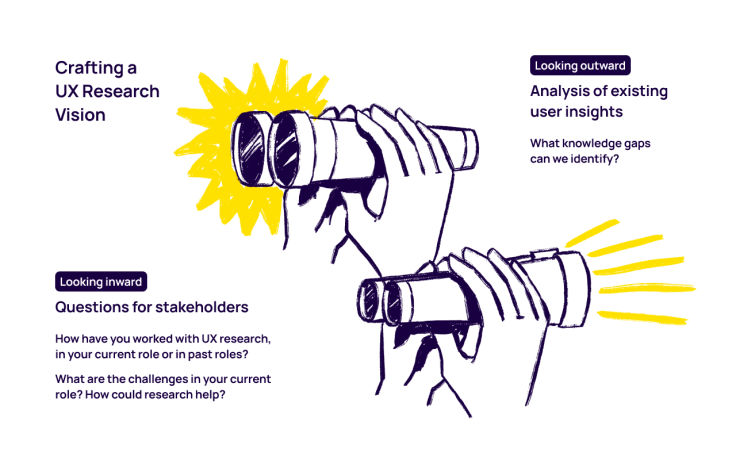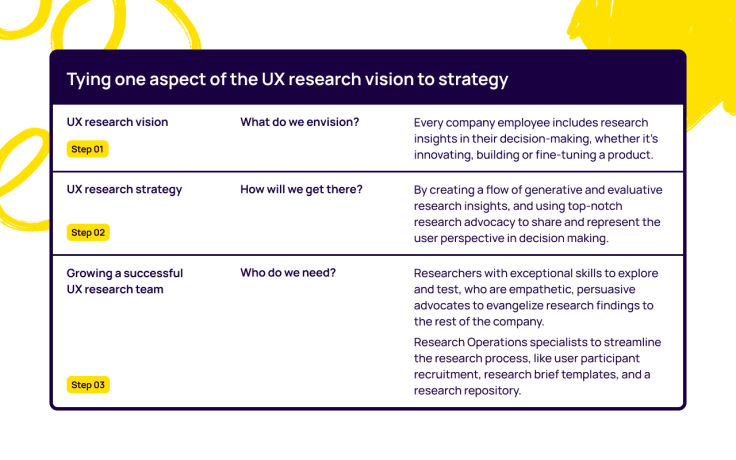Strategy and vision: how to grow a successful UX research team

Congratulations! You’ve been given the green light to build your UX research team. Whether you plan to expand your team by one or ten, this is an important moment that shows your company’s commitment to insights-driven decision-making.
You might be a solo UX researcher who’s convinced leadership to dive head-first into a research investment. You might be a design, insights, or product leader who will be spearheading the growth. Whatever your background, if it’s your first time taking on this challenge, you’re probably wondering where to start.
You might want to dive into posting a vacancy. Perhaps you’re already thinking about who in your network might be able to help spread the word. To successfully grow a UX research team, consider crafting a vision and outlining a hiring strategy as crucial first steps.
Crafting a long-term UX research vision
The first step in growing a successful UX research team is to craft a vision for UX research. In a nutshell, a vision encompasses goals you have for the future. Creating a vision means having the ability to imagine something that does not yet exist—to visualize the UX research practice, several years from now, in its most desirable form. This is not something that you create in isolation.
To craft a vision, you’ll need to look inward, to understand the existing company mindset toward users and insights-driven decision making, and outward, to recognize the ideal experience users could have with your product or service.
If you’ve been a practicing UX researcher for any amount of time, you learned early on that your responsibility isn’t just understanding your company’s users. It’s also understanding the users of your insights. Those users are company leaders who are in a position to digest and adopt research insights in their business decisions. To ensure the vitality of the team you are about to grow, you need to appreciate what will work for them.
In a nutshell: looking inward to understand leadership’s mindset toward user insights* is as important as understanding your users.
It’s also vital to look outward, which means becoming an expert on existing user research within your company. If you have researchers, designers, or others who have conducted UX research on your team, interview them, too. This process will help you articulate what the ideal experience could look like for users.
How to Craft a UX Research Vision

Once you have a solid understanding of your key stakeholder’s views toward UX research and you feel confident about what you know (or what you don’t know) about the users, it’s time to create a vision. As you write, embrace this opportunity to advocate for your users. Remember: Your vision needs to consider the perspective of your stakeholders, who will often be business-oriented: they want growth, they want success, and these goals may not necessarily be fully oriented toward research insights.
It’s essential to find a balance between acknowledging business goals to get leadership buy-in and pushing leadership thinking forward in order to grow a more insights-driven organization.
Create a hiring strategy for growing your UX research team
You’ve created a UX research vision and shared it with key stakeholders. You’ve iterated on the content and structure with their feedback. Now it’s time to think about how you will get there—what strategic steps are necessary to make that vision happen.
Note that UX research strategy can refer to many different things. For example: how best to advocate for your insights internally, how to create a user participant pool for research, or how to grow a culture of excellence as your team expands. Here, the focus is on a UX research strategy for growing your team, in other words, who you’ll need to get on the team to make your vision become a reality.
Like vision, you should create strategy through involving the appropriate stakeholders. It’s also vital to continuously refer back to your vision and the ideal state toward which you want your UX research practice to grow.
Example of how to tie strategy and vision to a hiring plan

Which product areas of your company need the input of UX researchers? Do you want to expand stakeholders’ appetite for qualitative discovery research? Finding researchers with solid ethnographic and qualitative backgrounds in generative research is a must. Does your company have an analytics-heavy orientation? Do stakeholders need to be taking into account more qualitative insights? Mixed methods researchers who can seamlessly communicate with their data expert counterparts could be a good idea. Does your company have a strong market research team? Bringing in a quantitative UX researcher who can provide the user perspective on market research is invaluable.
What seniority level are you seeking? If your company is already relatively large and you need researchers to come in as professionals independently working with product, tech, and design stakeholders, then it’s better to hire researchers with a corresponding level of experience. If you (or a research colleague) have time and space to mentor incoming researchers closely, consider hiring those at a junior level. You’ll also want to build Research Operations so UX research practice can become a finely tuned machine.
How will researchers be situated within the organization? This may not be your decision, but it’s important to consider whether researchers are embedded in product teams or are more centrally located before hiring can begin.*
Don’t forget about more practical aspects of your hiring strategy: How fast can you grow the team? What is possible from a budgetary perspective? If you are managing in addition to conducting research, what is the optimal rate at which you can hire and onboard new team members, ensuring you can give each person enough time to feel comfortable in their role, with a responsive manager at their side to guide them?
Keep in mind—especially in the rapidly scaling tech world—companies can quickly change. Vision and strategy are not things to create and put on a shelf. You will need to revisit them regularly to ensure they stay relevant to your company’s current culture and current challenges.
With a solid UX research vision and UX research hiring strategy in place, you can draw on both to write the job description—the first communication you will have with your future team members—and prepare your interviewing process.


